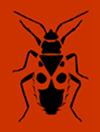PCR-based detection of prey DNA in the gut contents of the tiger-fly, Coenosia attenuata (Diptera: Muscidae), a biological control agent in Mediterranean greenhouses
IF 1.2
3区 农林科学
Q2 Agricultural and Biological Sciences
引用次数: 2
Abstract
The tiger-fl y Coenosia attenuata Stein (Diptera: Muscidae: Coenosiini) is a generalist predator that preys on several pests of greenhouse crops and is considered a biological control agent in the Mediterranean region. Previous behavioural observations identifi ed its preferred prey, but a more in-depth evaluation will benefi t from using Polymerase Chain Reaction amplifi cation of prey DNA remains in the gut of this predator. To evaluate the rate of decay and suitability of this method for use in the fi eld assessments, we carried out a laboratory feeding calibration experiment on 355 females of C. attenuata, which were killed at different intervals of time after ingestion (10 time points from 0 to 48 h). The prey species tested were: Trialeurodes vaporariorum (Westwood) (Hemiptera: Aleyrodidae: Trialeurodini), Liriomyza huidobrensis (Blanchard) (Diptera: Agromyzidae), Diglyphus isaea (Walker) (Hymenoptera: Eulophidae: Cirrospilini), Bradysia impatiens (Johannsen) (Diptera: Sciaridae) and Drosophila mercatorum Patterson & Wheeler (Diptera: Drosophilidae: Drosophilini). Based on a probit model, amplifi cation success of prey DNA declined exponentially with increasing time after ingestion. The half-time molecular detection differed between species, ranging from an average of 5 h for T. vaporariorum and D. isaea, 6 h for B. impatiens, 15 h for L. huidobrensis to more than 40 h for D. mercatorum. This study confi rmed the feasibility of using DNA based detection to identify prey species in the gut contents of C. attenuata and provided calibration curves for a better understanding of predation activity in this agroecosystem. * Present addresses: S.G. Seabra – Instituto de Higiene e Medicina Tropical, Universidade Nova de Lisboa, Rua da Junqueira no 100, 1349-008 Lisboa, Portugal; J. Martins – Ascenza Agro, Lda., Alameda dos Oceanos 1.06.1.1, 1990-207 Lisboa, Portugal; I. Freitas – CIBIO/InBIO, Research Center in Biodiversity and Genetic Resources of the University of Porto, Vairão, Portugal INTRODUCTION Generalist invertebrate predators may be important biological control agents against crop pests, as shown in a number of manipulative fi eld experiments (Symondson et al., 20 02). When considering introducing or enhancing a particular generalist predator species for pest control, its prey preference and effect on pests (target) and non-pests (non-target) should be studied (Stilin & Simberloff, 2000; Louda et al., 2003), even when native control agents are considered (Howarth, 2000). Field observations of predator preferences are not always feasible and molecular anaEur. J. Entomol. 118: 335–343, 2021 doi: 10.14411/eje.2021.035基于聚合酶链式反应检测地中海温室生物防治剂——虎蝇(Diptera:蝇科)肠道内容物中的猎物DNA
虎fly Coenosia defensia Stein(直翅目:蝇科:Coenosini)是一种多面手捕食者,捕食温室作物的几种害虫,被认为是地中海地区的生物防治剂。先前的行为观察确定了它喜欢的猎物,但更深入的评估将受益于使用聚合酶链式反应扩增这种捕食者肠道中残留的猎物DNA。为了评估衰减率和该方法在现场评估中的适用性,我们对355只雌性衰减C.attenuta进行了实验室喂养校准实验,这些雌性衰减C.detenuta在摄入后的不同时间间隔(0至48小时的10个时间点)被杀死。测试的猎物种类有:蒸汽斑蝶(Westwood)(半翅目:Aleyrodidae:Trialeurodini)、斑潜蝇(Blanchard)(双翅目:Agromyzidae)、灰蝶(Walker)(膜翅目:Eulophidae:Cirrospilini)、凤仙花(Johannsen)(双翅目:Sciaridae)和果蝇(双翅目的:果蝇科:Drosophilini)。基于probit模型,猎物DNA的扩增成功率随着摄入后时间的增加呈指数级下降。不同物种的半时间分子检测不同,从蒸发T.vaporariorum和灰蝶D.isaea的平均5小时,凤仙花B.impatiens的平均6小时,灰蝶L.huidobrensis的平均15小时到汞蝶D.mercatorum的平均40小时不等。这项研究证实了使用基于DNA的检测来识别衰减梭菌肠道内容物中猎物物种的可行性,并为更好地了解该农业生态系统中的捕食活动提供了校准曲线。*现地址:S.G.Seabra–葡萄牙里斯本新里斯本大学热带卫生与医学研究所,邮编:100,1349-008;J.Martins–Ascenza Agro,Lda。,Alameda dos Oceanos 1.06.1.1,1990-207葡萄牙里斯本;I.Freitas–CIBIO/InBIO,葡萄牙瓦良港波尔图大学生物多样性和遗传资源研究中心简介一般无脊椎动物捕食者可能是对抗作物害虫的重要生物控制剂,如许多现场操作实验所示(Symondson等人,20 02)。在考虑引入或增强特定的多面手捕食者物种进行害虫控制时,应研究其猎物偏好以及对害虫(目标)和非害虫(非目标)的影响(Stilin&Simberloff,2000;Louda等人,2003),即使考虑了本土控制剂(Howarth,2000)。对捕食者偏好的实地观察并不总是可行的,而且是不可预测的。J.昆虫。118:335-3432021 doi:10.144411/eje.2021.035
本文章由计算机程序翻译,如有差异,请以英文原文为准。
求助全文
约1分钟内获得全文
求助全文
来源期刊
CiteScore
2.30
自引率
7.70%
发文量
43
审稿时长
6-12 weeks
期刊介绍:
EJE publishes original articles, reviews and points of view on all aspects of entomology. There are no restrictions on geographic region or taxon (Myriapoda, Chelicerata and terrestrial Crustacea included). Comprehensive studies and comparative/experimental approaches are preferred and the following types of manuscripts will usually be declined:
- Descriptive alpha-taxonomic studies unless the paper is markedly comprehensive/revisional taxonomically or regionally, and/or significantly improves our knowledge of comparative morphology, relationships or biogeography of the higher taxon concerned;
- Other purely or predominantly descriptive or enumerative papers [such as (ultra)structural and functional details, life tables, host records, distributional records and faunistic surveys, compiled checklists, etc.] unless they are exceptionally comprehensive or concern data or taxa of particular entomological (e.g., phylogenetic) interest;
- Papers evaluating the effect of chemicals (including pesticides, plant extracts, attractants or repellents, etc.), irradiation, pathogens, or dealing with other data of predominantly agro-economic impact without general entomological relevance.

 求助内容:
求助内容: 应助结果提醒方式:
应助结果提醒方式:


